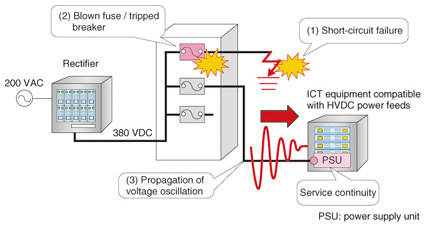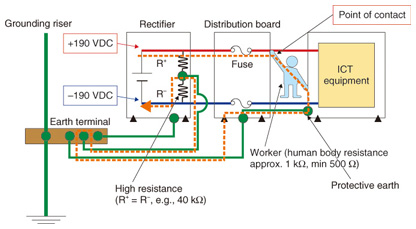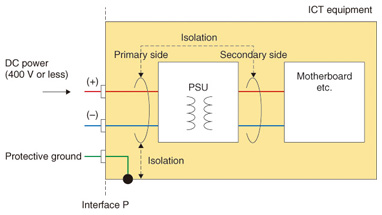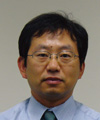 |
|||||||||||||
|
|
|||||||||||||
|
Global Standardization Activities Vol. 11, No. 3, pp. 42–47, Mar. 2013. https://doi.org/10.53829/ntr201303gls Trends in the International Standardization of HVDC Power FeedsAbstractHigher-voltage direct current (HVDC) power feeds are attracting attention as an efficient means of supplying 380-V DC electricity to datacenters and telecommunications facilities, and it is expected that this technology will eventually be put to practical use in many places worldwide. In this article, we describe the characteristics of HVDC power feeds and the international standardization efforts related to this technology, including an overview of ITU-T Recommendation L.1200 of May 2012 ("Direct current power feeding interface up to 400 V at the input to telecommunication and ICT (information and communications technology) equipment"). 1. IntroductionIn recent years, with the arrival of cloud computing and other network-enabled technologies, demand for communications and datacenters has continued to grow. However, as more equipment is installed in datacenters, their power consumption is steadily increasing. This trend is not exclusive to Japan, but is being seen all over the world. To realize a sustainable low-carbon society, the need for greener, more energy-efficient information and communications technology (ICT) equipment and facilities has therefore been recognized as a pressing issue. Worldwide attention has recently been focused on the idea of distributing direct current (DC) electric power inside datacenters and supplying the servers directly with higher-voltage DC (HVDC) power feeds as a key technology for reducing losses [1], [2]. In response to this trend, international standards organizations such as the ITU-T (International Telecommunication Union, Telecommunication Standardization Sector) and IEC (International Electrotechnical Commission) are now working on the standardization of device specifications, system configurations, safety measures, and component/device specifications that are needed for the practical implementation of this technology. 2. Benefits of HVDC power feedsA comparison of alternating current (AC) and DC power feed systems in a datacenter is given in Fig. 1. The internal components (CPU (central processing unit), memory, etc.) of the ICT equipment (servers etc.) operate with DC supply voltages such as 5 V and 3.3 V, and the backup storage battery for use during power outages also runs on DC. With an AC power feed, power conversion between AC and DC is typically performed four times in order to connect this equipment, which results in conversion losses. By contrast, with a DC power feed, the AC power can be converted into DC and connected directly to the storage battery. Therefore, power conversion is typically performed just twice (including DC/DC conversion inside the equipment), so a DC feed can in principle achieve better efficiency due to the need for fewer power conversion stages than with an AC power feed.
ITU-T Recommendation L.1200 assumes that a DC voltage of 380 V will be used. This is because this voltage has traditionally been used as the intermediate bus voltage of server power supply units worldwide, making it highly compatible with existing equipment. Also, since the higher voltage means that the power current can be suppressed to approximately one eighth that of a conventional DC 48 V power feed system used for communication equipment, it can reduce the power distribution losses and heat dissipation. These characteristics make the power supply equipment more efficient and compact and allow the use of thinner power distribution cables, thereby reducing the wiring and construction costs while allowing the equipment to be laid out with greater flexibility. Another reason why this power feed system has attracted international attention is the high reliability of DC power feed systems. Although there is always a risk of breakdowns, DC power feeds are known to be over ten times as reliable as AC power feeds because the use of AC necessitates complex mechanisms such as frequency synchronization during power switching. By contrast, with DC power feeds the storage battery can be connected directly to the power supply line, and the likelihood of breakdowns is therefore smaller [3]. When applied to higher-voltage DC power feeds, the designation HVDC corresponds to a voltage approximately eight times higher than the DC 48 V traditionally used to power communication equipment, and this is the definition that started to take hold in the field of communications facilities. However, HVDC is also used in the field of DC power supply technology, where it refers to electrical power systems operating at 100 kV or more. To avoid confusion, the ITU-T uses the designation “up to 400 VDC” instead of HVDC when referring to power feed systems. 3. Activities of standards organizationsDiscussions on the standardization of HVDC power feeds operating at up to 400 V are mostly being held by the ITU-T, the IEC, and the ETSI (European Telecommunications Standards Institute). These three organizations have coordinated their efforts through liaison relationships enabling them to cooperate and exchange information. The groundwork for standardization of HVDC power feeds aimed at datacenters and communication buildings was started by the ITU-T in 2009. In May 2012, the ITU-T gave its approval to Recommendation L.1200 (“Direct current power feeding interface up to 400 V at the input to telecommunication and ICT equipment”)* by study group 5 (SG5). In the same year, the ETSI published a similarly specified European standard EN300-132-3-1 (“Power supply interface at the input to telecommunications and datacom (ICT) equipment”). NTT also participated in the discussion on this ETSI standard as an associate member. The IEC has also continued to work proactively. The SMB (Standardization Management Board)/SG4 (low voltage DC distribution systems) is discussing the issues of DC power distribution at voltages up to 1500 V, as well as the items that require standardization, for application not only to communication buildings and datacenters but also to ordinary buildings, households, solar power generation facilities, and to storage batteries (including electric vehicles). It is also studying the technical issues related to DC power delivery and a systematic approach to standardization, and is currently preparing a roadmap for this field. TC (Technical Committee) 23/WG (Working Group) 8 is conducting draft deliberations on connectors for DC 400-V power feeds (rated at 2.6 kW and 5.2 kW), TC64 is studying the construction, maintenance, and safety protection of indoor electrical facilities, and SC (Subcommittee) 23 is conducting fresh discussions relating to DC circuit breakers. Another standardization organization is the EMerge Alliance, which is also engaged in discussions relating to the preparation of standards [4]. This is a North American industry organization that promotes the use of DC power distribution within buildings (for lighting etc.). It plans to publish a standards document within the 2012 fiscal year. Another North American industry organization called The Green Grid [5] aims to improve the efficiency of resources used by data centers and in 2010 published a white paper on HVDC power feeds (Japanese translation published in 2011).
4. ITU-T SG5 standardization activitiesWithin ITU-T SG5, a working party focusing on environment and climate change issues (WP3/5: Working Party 3/Study Group 5), has been investigating how the use of ICT is affecting the environment and has been working on related recommendations (Fig. 2). As of December 2012, WP3/5 has been addressing six questions (Qs). One of these questions (Q19/5) is being discussed in relation to three points connected with HVDC power feeds: (1) specifications of ICT equipment power supplies compatible with HVDC power feeds, (2) power feed system configurations, and (3) power feed performance evaluation methods.
5. Overview of L.1200ITU-T Recommendation L.1200 is a basic specification relating to ICT equipment power supplies that are compatible with HVDC power feeds. NTT and other Japanese members have contributed greatly to the drafting work of this recommendation. This recommendation applies primarily to communication carrier buildings and datacenters and describes the minimum requirements and specifications for achieving reliable communication services. An overview of a power feed system to which L.1200 applies is shown in Fig. 3. The basic configuration is based on a DC 48-V system that is used worldwide. To show the interface conditions (power supply specifications) at the input terminals of power supplies for ICT equipment, the points of contact between the power feed system and ICT equipment are defined as interface P, for which various types of electrical specifications are provided.
5.1 Operating voltage range of ICT equipmentA crucial item in determining the power source specifications is the equipment’s operating voltage range. Here, the voltage range is set by assuming a configuration where electricity is supplied directly from a storage battery, which is the main feature of a DC power feed, and the standard voltage range was chosen to be 260–400 V. ICT equipment compatible with newly installed HVDC power feeds is required to continue operating stably within this voltage range without any stoppages, failures, or malfunctions. With regard to the voltage range setting when considering the operation of this storage battery during power outages, there has been considerable support from communications carriers in Europe. In the initial discussions on the standardization of voltage ranges, no agreements could be reached for several years. Meanwhile, NTT was also participating in the discussions on the ETSI standard (EN300-132-3-1), which was approved in 2011. Furthermore, research in this area stimulated a lot of product development and verification trials, mainly in Europe and North America, and this subsequently led to the adoption of the voltage range proposed by Japan and Europe in ITU-T Recommendation L.1200. An agreement was reached on the voltage range in 2011, and standardization was achieved in 2012. 5.2 Dealing with transient voltage fluctuationsIt is essential to consider transient voltage fluctuations in power supply devices for communications equipment. As shown in Fig. 4, even when transient voltage fluctuations occur due to a problem such as a blown fuse or tripped breaker in the power feed system, the ICT equipment must continue with normal operations (service). The test methods reference the IEC61000-4 series, and the test equipment is compatible with existing commercial products. Tests are performed with standard voltage fluctuations and voltage drops relative to the test voltage chosen according to system requirements.
5.3 Grounding and isolationIn this specification, grounding is implemented by a high-resistance scheme considering the safety not only of the engineers using the ICT equipment but also of the facility managers. An overview of this grounding scheme is shown in Fig. 5. When there is a ground fault or current leakage, the large intervening resistance suppresses the resulting current so that even if someone touches the equipment, the flow of current is so weak as to cause no injury or discomfort. Power sources for ICT equipment are also required to use isolating converters as shown in Fig. 6, and are configured so that the primary side (DC feed) and secondary side (e.g., motherboard) are isolated from each other in order to provide secure protection against electric shocks.
6. Future prospectsHVDC power feed technology shows great promise as a means of reducing the power consumption of ICT equipment and facilities because the losses incurred during power conversion are small in principle. It is also characterized by a strong affinity with DC power sources such as those used in solar electricity generation, electric vehicles, and fuel cells, and is expected to be used in a wide range of applications. At the NTT Group, we are pressing ahead with international standardization efforts in order to promote the widespread use and technical development of DC power feed technology. References
|
|||||||||||||

















